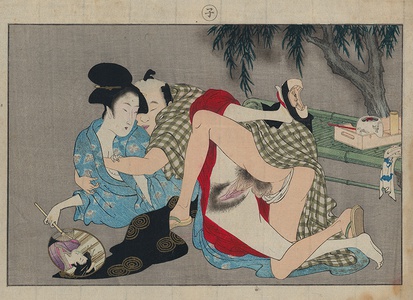| Method | Woodblock (nishiki-e) |
| Artist | Migita Toshihide (1863-1965) |
| Published | c. 1880 |
| Dimensions | Sheet 217 x 275 mm |
| Notes |
Series: Seishi Ai-oi Genji: A True-life Devote Genji A print of lovers outside with a bench and a willow tree in the background. From a set of twelve prints where lovers are compared to the the twelve Japanese zodiac signs. Printed using metallic inks and gauffauge. The Meiji Era marked the end of the Shogunate, the restoration of the Imperial Family, and the full opening of Japan to the West. As Japan opened up, the Meiji administration sought to bring Japanese societal practices in line with Western standards of morality. These factors had several effects on Meiji shunga output. As Japanese society became more open tastes changed at the same time that artists began to be schooled in Western styles. Printmakers of ukiyo-e no longer produced any prints, but other forms of shunga were still being made through the end of the nineteenth century and into the twentieth. This material was still being produced using deluxe printing methods, but it was stylistically simpler and more often produced as suites of prints and painting rather than in book format. Shunga is the term used for the body of erotic imagery produced in Japan from 1600 to 1900. The term shunga means spring pictures, a euphemism for sex, and is one of several names for erotic material produced in Japan. Shunga took different formats: painted hand scrolls, painted books, printed books and albums, and sets of prints which were sometimes sold in wrappers. As prints they are one of the genres of ukiyo-e, or Floating World prints, which also include fukeiga (landscape prints), and bijin-ga (prints of beautiful women). Most of the major ukiyo-e artists produced shunga material at some point during their careers, including Utamaro (who produced more erotic books than non-erotic books), Hokusai, and Hiroshige. Produced at the same time as the introduction of full colour woodblock printing, shunga prints and books were made using the most lavish and complicated printing techniques, including gauffrage, metallic inks, mica, complicated printed patterns, and multicolour printing using a high number of different colours. Although prolific in its number and variety, shunga should be seen as more representative of the ideals of the ukiyo, with its emphasis on mutual pleasure, rather than as an accurate representation of Japanese attitudes and practices of sexuality. Shunga present an invitation to pleasure through the bliss of lovemaking and though largely heteronormative, they portray the full gamut of couplings, married or otherwise, often surrounded by lavish settings and objects of pleasure. Migita Toshihide (1863-1965) was a Meiji painter and woodblock artist born in Oita-ken, Shizuoka Province with the name Migita Toyohiko. His father was a Kano style painter. He started in studying Western-style painting under Kunisawa Shinkuro (1847-1877) from the age of 17. He then moved to Edo where he was a pupil of Yoshitoshi who gave him the name Toshihide. He also studied with Kinisawa Shimburō and he studied Japanese-style painting with Watanabe Shotei (1851-1918) He is most well known for his depiction senso-e (war prints)of the Sino-Japanese and Russo-Japanese wars. He also designed prints of actors, bijin-ga, newspaper illustrations, kuchi-e (illustrations for novels). He was a member of the Nihon Bijutsu Kyokai (Japan Art Association) and Nihon Bijutsuin (Japan Art Institute), frequently serving as a juror for these groups. Among his pupils were Ikeda Terukata (1883-1921), Ikeda Shōen (1886-1917), Kaburaki Kiyokata (1878-1972) and Hirezaki Eihō (1881-1968). Condition: Some light creasing. |
| Framing | unmounted |
| Price | £200.00 |
| Stock ID | 53209 |

